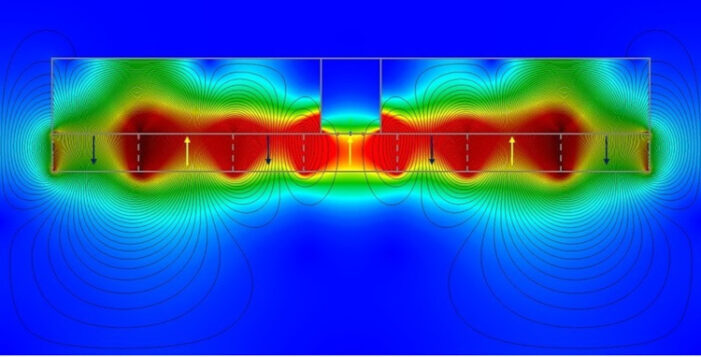Magnet FAQ
What is a pot magnet?
A pot magnet is a simple magnet placed within a metal cup or channel. The mounting magnet usually comes with a hole, nut, or bolt for helping aid in various mounting. The metal mounting feature helps protect the magnet from damage, and also amplifies the strength of the magnet. The magnetic field is amplified at the surface it is mounting to. This amplification process makes the simple magnet up to 10x stronger than when outside metal cup or channel. In this process of field amplification, it also has contained the magnetic field from potential data interference. It’s why it’s a popular choice over simple magnets. 🧲💪
What is a permanent magnet?
Permanent magnets are made from ferromagnetic materials such as iron, nickel and other alloys of rare-earth metals and minerals where the magnetic field is generated by the internal structure of the material itself. Permanent magnets produce a persistent magnetic field that retains its magnetic properties in the absence of an inducing field or current. Permanent rare earth magnets are not easily demagnetized.
What is a rare earth magnet?
Rare Earth magnets are relatively recent inventions that are made out of the rare earth group of elements such as neodymium-iron-boron. Rare earth magnet materials far exceed those of ceramic/refrigerator or alnico materials, making them the preferred magnetic material for many mechanical applications. The performance and affordability of rare earth magnets make them critical components in many technological and industrial applications.
How permanent is a magnet’s strength and what affects them?
Over the course of 100 years, a properly specified and cared-for rare earth magnet should lose no more than 1% of its magnetic strength. Here are some factors that can impact a magnet’s strength:
- Heat: Exposing the magnet to temperatures above its maximum rated level can decrease its strength. For standard rare earth material, the maximum temperature is 80°C
- Impact: Sharp impacts from physical abuse or handling can lead to fractures in the magnet material, weakening its strength. The brittle nature of the magnet material makes it susceptible to damage.
- Welding: Welding near the magnet can also result in decreased performance due to heat or current generated during the welding process.
- Liquid Ingress: If the magnet housing is compromised and moisture enters, oxidation of the magnet material occurs over time.
Remember, proper care and adherence to guidelines can help your rare earth magnet maintain its strength for a century and beyond! 🧲🕰️
What are magnetic poles?
Magnetic poles are the surfaces from which the invisible lines of magnetic flux emanate and connect on return to the magnet. The north pole is defined as the pole of a magnet that, when free to rotate, seeks the north pole of the earth. In other words, a magnet’s north pole will seek the earth’s north pole. Likewise, the south pole of a magnet seeks the south pole of the earth. The north or south pole of a magnet can be identified if marked.
What is the operating temperature of a rare earth pot magnet?
A typical pot magnet can maintain its maximum pull force in temperatures ranging between -40°C – 80°C. Other additives can be added to increase the operating temperature range.
How do you properly handle and store magnets?
- Always handle neodymium magnets with care. Powerful magnets can snap together and can pinch your fingers or cause other injuries.
- Keep magnets away from magnetic media such as floppy disks, HHD, magnetic strip credit cards, hotel room keys, and CRT monitors.
- Keep neodymium magnets away from anyone with a pacemaker.
- Store magnets in closed containers so they don’t attract metal.
- If several magnets are being stored, they should be stored in attracting positions.
- Magnets are not toys and should be kept away from children and pets.
Can a magnet impact my smartphone?
Magnets will not impact your smartphone as newer devices contain solid-state drives which don’t use magnetism to store data. This makes them completely safe from magnetic interference. Equally, LCD or LED-based screens stop magnetic interference with their functionality. Believe it or not but you’ll find multiple rare earth magnets in your iPhone!
Can a magnet impact ethernet, WiFi or other electrical signals?
In general, a stationary magnet does not produce electromagnetic interference (EMI) on copper cables or WiFi signals. EMI is caused by rapidly changing electrical currents. Magnets generate a static magnetic field. EMI compromises the performance of electrical equipment by obstructing and degrading data. Since fiber optic cables are made of glass, a magnet will have no impact on the signal. Additionally, magnets do not boost WiFi signal strength.
The images below show the containment of the magnetic field within our UHD Series magnet and our Winnie MAG pot magnets.

The magnetic field of the WUMAG-1420UHD magnet assembly fastened to steel. The amplification and magnetic field containment is directed towards the fastening surface.

The magnetic field of the Winnie MAG pot magnet fastened to steel. The amplification and magnetic field containment is directed towards the fastening surface.
Still have questions? Email support@winnieindustries.com.

